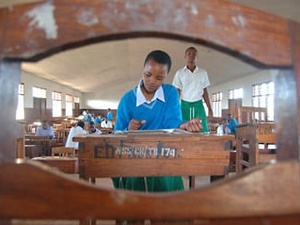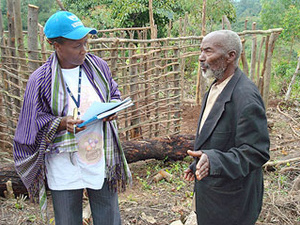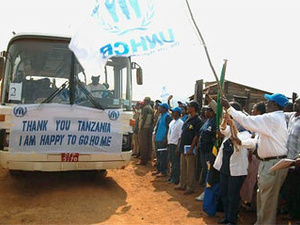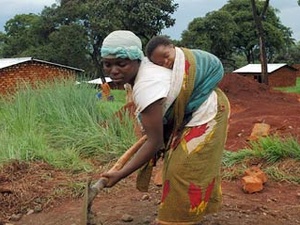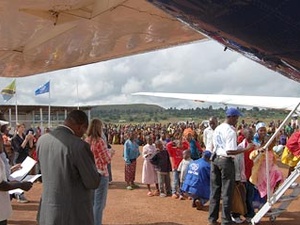Refugee population in Tanzania camps drops below 300,000
Refugee population in Tanzania camps drops below 300,000

A food distribution at a camp in Tanzania. The number of people in the camps is falling.
DAR ES SALAAM, Tanzania, February 1 (UNHCR) - The number of refugees housed in camps in Tanzania has fallen below the 300,000 mark for the first time in more than a decade, reflecting continuing improvement in the security situation in the Great Lakes region.
Some 287,000 refugees now live in the camps, which are run by the Tanzanian government, UNHCR and partner organisations. Most of the refugees originate from Burundi and the Democratic Republic of the Congo (DRC). The figure does not count the large number of refugees who have found shelter outside the camps.
"In early 2003, more than half a million people resided in the refugee camps in north-western Tanzania. It is a remarkable achievement that the number has dropped so significantly within a few years," said El Hillo, the UNHCR representative to Tanzania, adding that the figure had not been so low since 1996, when hundreds of thousands of Rwandan refugees returned home.
"Due to the decrease in the refugee population, we closed two refugee camps in 2006 and are planning to close another three camps by mid-2007. The administration and maintenance of each camp is costly and we use resources most effectively by consolidating camps with a relatively small population," El Hillo added.
The reduction in the refugee numbers is largely attributable to voluntary repatriation to both Burundi and the DRC. The UN refugee agency has helped more than a quarter-of-a-million people return to Burundi under an assisted voluntary repatriation programme launched in March 2002.
A similar programme for the DRC was initiated in October 2005, and more than 23,000 Congolese refugees have since returned home with assistance from UNHCR. Meanwhile, resettlement to third countries and local integration are also pursued as durable solutions for those refugees in Tanzania who cannot return to their countries of origin.
Refugees accommodated in the three camps due to close later this year will either opt to repatriate or be relocated to another camp. Plans for the closure of the camps are being developed in anticipation of a continuous reduction in the refugee population.
The objective for UNHCR and its partners in Tanzania is to assist 75,000 Burundians and 48,000 Congolese refugees repatriate voluntarily in the course of the year. Those deciding to return are encouraged by the further consolidation of peace and stability in their homelands, though the availability of basic social services remains a concern for many returnees.
The Tanzanian government, meanwhile, has welcomed the progress achieved and also encouraged more people to return home. Home Affairs Minister Joseph Mungai toured the camps last week to promote repatriation to Burundi while stressing that it should only be voluntary.
UNHCR's operation in Tanzania is one of its largest in Africa, with more than 250 staff caring for 287,000 refugees. The European Union and the United States are among the largest donors to the Tanzania operation.
By Mia Bülow-Olsen in Dar Es Salaam, Tanzania



